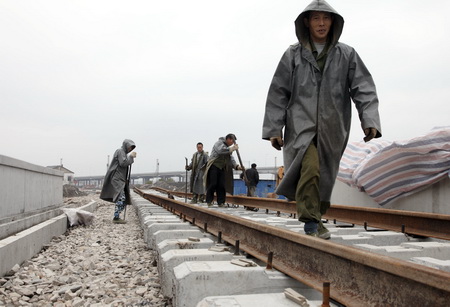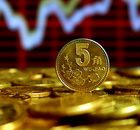Money
New credit may exceed govt target
By Wang Xiaotian (China Daily)
Updated: 2010-04-06 09:16
 |
Large Medium Small |
BEIJING: China's new credit in 2010 may well exceed the central government-set target of 7.5 trillion yuan ($1.1 trillion) as urban investment in fixed assets continues to grow on a large scale, analysts said.
In the first two months of this year, urban investment in fixed assets reached 1.3 trillion yuan, up 26.6 percent year-on-year, or 0.1 percentage points higher than the same period in 2009, according to the National Bureau of Statistics (NBS).
 |
|
Workers lay track near a new railway station in Shanghai. In 2009, total investment in fixed assets in China increased 30.1 percent year-on-year to 22.5 trillion yuan. [Agencies] |
Projects newly started this year totaled 18,462, a slight drop of 71, while total planned investment reached 1.06 trillion yuan, up 42.7 percent year on year, despite the government's pledge to cut the number of new projects from late last year in its effort to squeeze credit.
"That makes the (government) cap of 7.5 trillion yuan far from enough to sustain these projects," said May Yan, an analyst at Nomura International (HK) Limited.
Based on the NBS data, the average investment in a newly started project rose to 58 million yuan from 40 million yuan a year ago, which means the scale of these new projects has swollen, and some of them may be large infrastructure projects requiring additional input for many years, Yan said.
"That must bring continuously thriving demand for credit and raw materials," Yan said, estimating new credit this year would reach 10 trillion yuan if the investment trend in the first two months continues.
"Otherwise, many existing projects will be short of funding and non-performing loans will rise at banks, because, while some projects can be temporarily suspended, many cannot."
Fan Gang, director of the National Economic Research Institute at the China Reform Foundation, said it is very normal and necessary for some projects to be short of funding as the government takes steps to cool overheated investment.
"The central government intended to tighten new lending and control the supply of funding to those projects, in a bid to quell the investment fever and prevent asset bubbles," he said.
In 2009, total investment in fixed assets in China increased 30.1 percent year-on-year to 22.5 trillion yuan, 4.6 percentage points higher than the previous year. Urban investment rose 30.5 percent to 19.4 trillion yuan, 4.4 percentage points higher.
Analysts believed the 4 trillion yuan stimulus package, launched in late 2008, as well as unprecedented credit growth in 2009, promoted dramatic growth in investment and higher risks of asset bubbles.
| ||||
Tightening liquidity before tightening public investment may be very dangerous and prevent economic growth featuring low inflation, said Sun Mingchun, chief economist of Nomura China.
"Under such circumstances, banks will tend to lend money to public projects, and thus exclude private and manufacturing projects, which will not only worsen the economic imbalance but add to inflation risks in 2011 as manufacturing overcapacity disappears," he said.
Sun estimated the government would set out more specific measures to control new public projects and loosen the 7.5 trillion-yuan credit cap around June.












